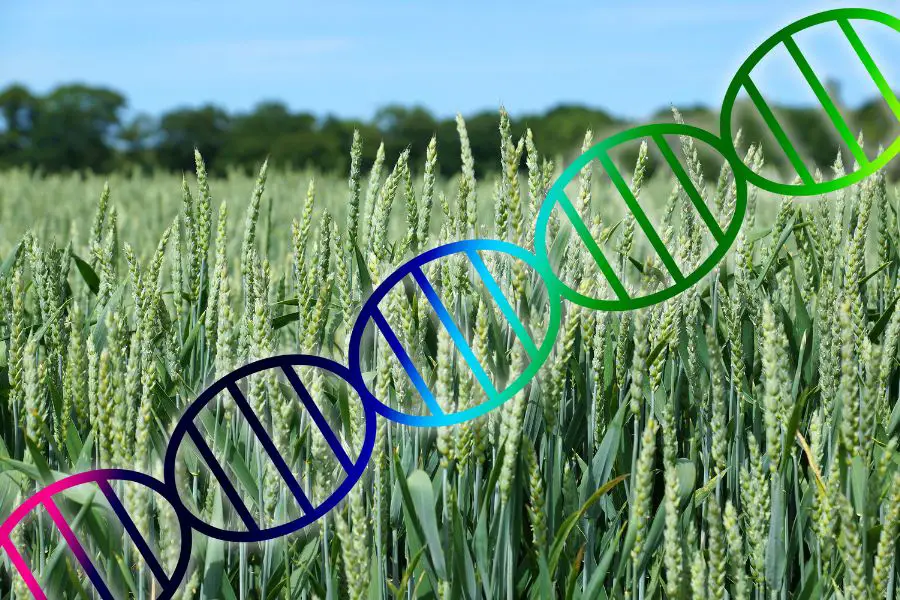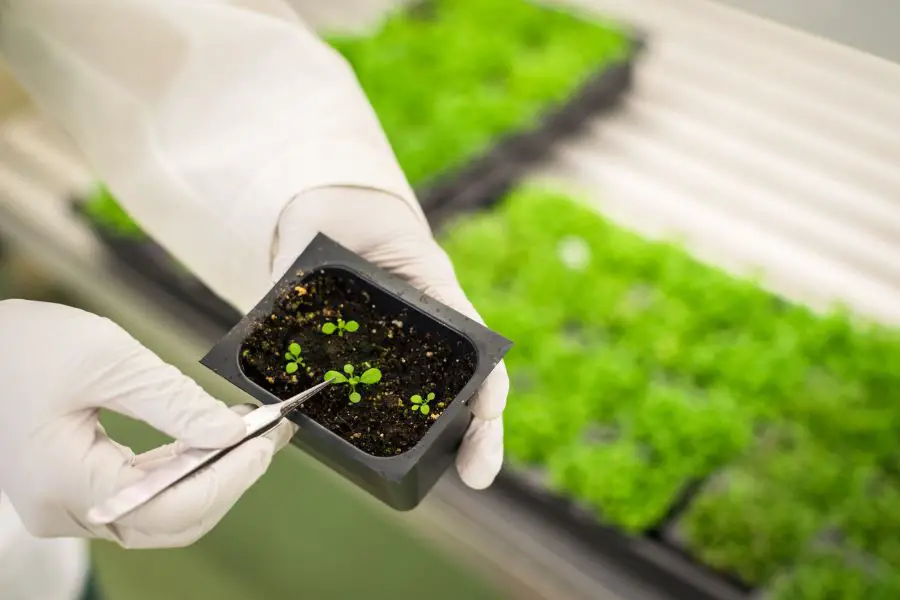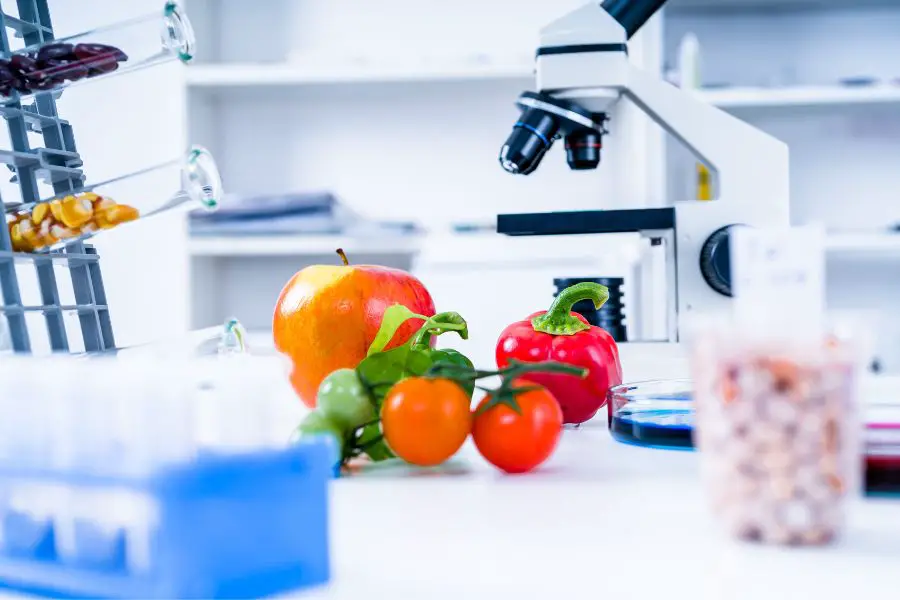The world’s population is projected to reach 9 billion by 2050. To prevent future food shortages, certain countries have turned to transgenic plants as a solution. Transgenic plants are crops that have been altered using genetic engineering techniques, allowing for the insertion of artificial genes into their DNA. The purpose of introducing these genes is to enhance shelf life and maximize productivity.
There are two main types of transgenic plants: herbicide-tolerant plants and pest-resistant plants. Herbicide tolerance refers to a genetically engineered trait in crops that enables farmers to control weeds by spraying herbicides. This simplifies field maintenance and leads to increased crop yields. On the other hand, pest-resistant plants are genetically modified to produce a toxic protein that makes them resistant to insect damage. By being resistant to pests, these plants reduce the need for harmful pesticides, benefiting both the environment and human health.
One of the primary advantages of transgenic plants is their ability to boost productivity. With genetically modified traits like herbicide tolerance and pest resistance, crops are less vulnerable to damage from weeds or pests, resulting in higher yields. This is particularly beneficial for developing countries where food scarcity is a major concern.

Nutritional Value
Furthermore, transgenic plants can also offer improved nutritional value. For example, golden rice, a genetically modified variety, contains elevated levels of beta-carotene, which the body converts into vitamin A. This has the potential to address vitamin A deficiency in developing countries, which can cause blindness and other health issues.
The future of transgenic plants looks promising, with ongoing research and advancements in the field. Scientists are working towards developing crops that are resistant to droughts, floods, and extreme temperatures. This has the potential to minimize crop loss due to unpredictable weather conditions, ensuring a more stable food supply.
However, concerns have been raised about the safety of consuming transgenic plants. Ongoing debates and discussions surround the potential long-term effects on human health and the environment. It is crucial to have comprehensive testing and regulations in place to ensure the safety of these plants.
Transgenic plants, also known as transgenic crops, have been created using genetic engineering techniques to alter the genetic makeup of plant cells. These genetically modified organisms (GMOs) have allowed scientists to manipulate the plant genome and introduce desirable traits into crop plants.
Insect-resistant crops, a type of transgenic plant, have been genetically modified to be resistant to insect pests. This trait helps protect the plants from damage caused by insects, reducing the need for harmful pesticides. This development has been particularly beneficial for developing countries, where agricultural productivity is crucial for food security.

Genetic Engineering Techniques
Genetic engineering techniques have revolutionized plant biotechnology, enabling scientists to enhance the characteristics of various plant species. This technology has opened up new possibilities for improving crop yields, nutritional value, and resistance to environmental stresses.
While some have raised concerns about the safety and long-term effects of transgenic plants, extensive research and regulatory measures are in place to ensure their safety. Organizations such as the National Academy of Sciences have conducted thorough evaluations of the benefits and risks associated with transgenic crops.
It is important to note that genetic modification is not a replacement for conventional plant breeding methods. Instead, it complements traditional breeding approaches by providing additional tools to enhance crop traits and address agricultural challenges.
Overall, the development and adoption of transgenic plants have the potential to revolutionize agriculture and address pressing global challenges in food production. Continued research and responsible use of genetic modification can contribute to a sustainable and resilient future for our food supply.

Types of Plants Transgenic
Transgenic plants, also known as genetically modified plants or genetically modified crops, are created through genetic engineering techniques. These plants involve the insertion of genes from other species into the plant’s genome, ranging from plants within the same kingdom to species across different kingdoms.
The inserted DNA often requires modification to ensure its successful integration into the host organism, such as plant cells.
The development of genetically modified crops has been driven by the need for insect-resistant plants and the challenges faced in conventional plant breeding. Insect pests pose significant threats to crop plants, and genetically modified organisms have been engineered to resist these pests, offering improved crop yields and reduced reliance on pesticides.
This technology has shown promising results, particularly in developing countries where agricultural productivity is crucial.
The study of transgenic plants and their applications in plant biotechnology has been extensively researched by various scientific institutions, such as the National Academy of Sciences. Genetically modified plants have the potential to address important agricultural challenges and contribute to global food security.
It is important to note that the debate surrounding genetic modification remains complex and multifaceted, with considerations for environmental impact, consumer concerns, and regulatory frameworks.
Nonetheless, the advancements in genetic engineering techniques continue to shape the future of crop production and plant biotechnology.

Benefits of Plants Transgenic
Transgenic plants, also known as genetically modified plants or GM crops, have been utilized for a significant period of time in the production of agricultural commodities. Despite advancements in technology and improved productivity, food scarcity remains a global concern.
Genetically engineered plants offer various advantages, including enhanced production, higher nutritional content, and reduced transportation costs. However, while these plants benefit farmers, consumers may not perceive additional advantages beyond accelerated growth. The cultivation of transgenic crops with insect resistance genes derived from Bacillus thuringiensis is expected to increase in the coming years.
One specific type of transgenic plant is herbicide-resistant plants, which possess a remarkable tolerance to herbicides. Glyphosate, a widely used ingredient in herbicides, is employed in the production of transgenic potato, tomato, cotton, tobacco, and other crops.
Another type of transgenic plant is insect-resistant plants, which are engineered to contain toxic genes that provide protection against insects and pests. These genes are introduced directly into the plant’s genome through recombinant DNA methods. Cultivating transgenic crops with insect resistance genes has proven effective in reducing the usage of insecticides in cotton farming.
Virus-resistant plants represent yet another type of transgenic plant. These plants are modified by incorporating viral coat proteins into their genetic makeup. Examples of virus-resistant plants include YMV-resistant black gram, RSV-resistant cowpea, and YMV-resistant green gram.
There is an urgent need to develop crop plants that can thrive in conditions such as highly tilled soil and utilize herbicides as a substitute for tillage. This is crucial for addressing global issues such as water availability and efficient use of crops.
Genetic engineering techniques and the application of plant biotechnology play a significant role in the development of these traits in crop plants.
It is worth noting that the use of genetic modification in plant breeding complements conventional plant breeding methods.

National Academy of Sciences and Plant Transgenic
The National Academy of Sciences (NAS) is a private, nonprofit institution that provides expert advice on science, technology, and health-related issues to the government. The NAS has conducted extensive research on transgenic plants, which are genetically modified (GM) crops with altered plant cells and genomes. They have established guidelines for the safe use of these GM crops.
In 2000, the NAS released a comprehensive report titled “Genetically Modified Pest-Protected Plants: Science and Regulation.” This report discussed the benefits, risks, and regulations surrounding transgenic crops. It emphasized the potential environmental advantages of genetically modified plants, such as reduced pesticide use and increased crop yields. The report also addressed concerns about gene flow between transgenic crops and wild relatives of the same species.
In 2016, the NAS published another report titled “Genetically Engineered Crops: Experiences and Prospects.” This report evaluated the evidence regarding the safety and environmental impacts of genetically modified crops. The conclusion was that there was no significant difference in risks between genetically modified and conventional crops.
The NAS continues to study the potential benefits and risks of transgenic plants, providing valuable insights for policymakers, researchers, and consumers. Their research supports responsible and evidence-based decision-making regarding the use of genetically modified plants in agriculture, ensuring the assessment of risks to human health and the environment in the context of biotic and abiotic stress. Additionally, the NAS research contributes to the understanding of foreign genes, recombinant proteins, and the development of genetically engineered foods (GM foods).
The National Academy of Sciences recognizes the potential of genetically modified organisms (GMOs) to contribute to sustainable agriculture and food security, particularly in developing countries.
In summary, genetic modification techniques have allowed for the creation of transgenic plants with enhanced traits, offering potential solutions to various agricultural challenges. These advancements in plant biotechnology continue to shape the future of crop production and hold promise for addressing global food security issues.

Plant Cells and Genetically Modified Plants
Genetic modification involves the alteration of an organism’s genetic makeup. In plant biotechnology, this is achieved through recombinant DNA technology, which allows scientists to transfer genes between different species.
Plant cells are unique in that they have cell walls made up of cellulose, providing structural support and protection. This poses a challenge for introducing foreign genes into plant cells, as the cell wall must be breached for the gene transfer to occur.
Genetically Modified Crops and Labeling
One ongoing debate surrounding genetically modified crops is the issue of labeling. Some argue that consumers have a right to know if their food contains genetically modified ingredients, while others argue that mandatory labeling would be costly and unnecessary.
In the United States, the FDA requires labeling for genetically modified foods only if there are significant differences in nutritional content or allergenicity compared to their non-modified counterparts. However, proposed legislation has been introduced in various states to mandate labeling of genetically modified foods.
There is also disagreement among countries regarding the regulation of genetically modified crops. Some have strict regulations and mandatory labeling, while others have looser regulations or no regulatory framework at all.

Future of the Transgenic Plants
Genetically modified crops, also known as transgenic crops, offer a significant solution to address the global food shortage. However, there are still questions surrounding their cultivation. Despite the promising potential to alleviate hunger worldwide, there are associated health and environmental concerns. The commercial benefits of transgenic crops include reducing post-harvest loss and improving shelf life. Additionally, they offer improved weed control, decreased crop loss from insects and viruses, reduced insecticide usage, enhanced nutritional quality, and effective production of hybrid seeds. These advancements help address the scarcity of crops and provide superior seeds in the seed industry. The field of crop research encompasses pharmaceutical and food processing, making it crucial to explore the potential of genetic engineering techniques, transgenic plants, and genetically modified organisms in the plant genome. This includes insect-resistant crops, conventional plant breeding, and the development of GM plants to combat insect pests, benefitting plant species and other plants worldwide. The National Academy of Sciences recognizes the importance of plant biotechnology and genetic modification in addressing global food challenges, particularly in developing countries.
Conclusion
To conclude, it can be stated that researchers heavily rely on the provision of medicines and vaccines to effectively utilize transgenic food in developing countries. However, further research is required to fully understand the environmental friendliness of transgenic crops, their extended storage capabilities, and their consumption without posing health hazards. The introduction of medications into these crops not only facilitates transportation and storage but also significantly extends their shelf life.
Transgenic plants, also known as genetically modified plants or genetically modified crops, are created through genetic engineering techniques. These genetically modified organisms have altered plant cells and modified plant genomes, resulting in traits such as insect resistance. In developing countries, the utilization of transgenic crops can address challenges related to insect pests and enhance the productivity of crop plants.
Transgenic plant biotechnology offers promising solutions to improve crop yield and enhance the resistance of plant species to various stresses. It complements conventional plant breeding methods and can contribute to sustainable agriculture. The National Academy of Sciences recognizes the potential benefits of genetic modification in agriculture and highlights the importance of careful evaluation and regulation of GM crops.
By harnessing the power of genetic modification, scientists can develop insect-resistant crops and other plants with desirable traits. This technology has the potential to revolutionize agriculture and contribute to food security in developing countries.
Note: The revised text includes the provided keywords and expands on the original content while maintaining a native English writing style.





























